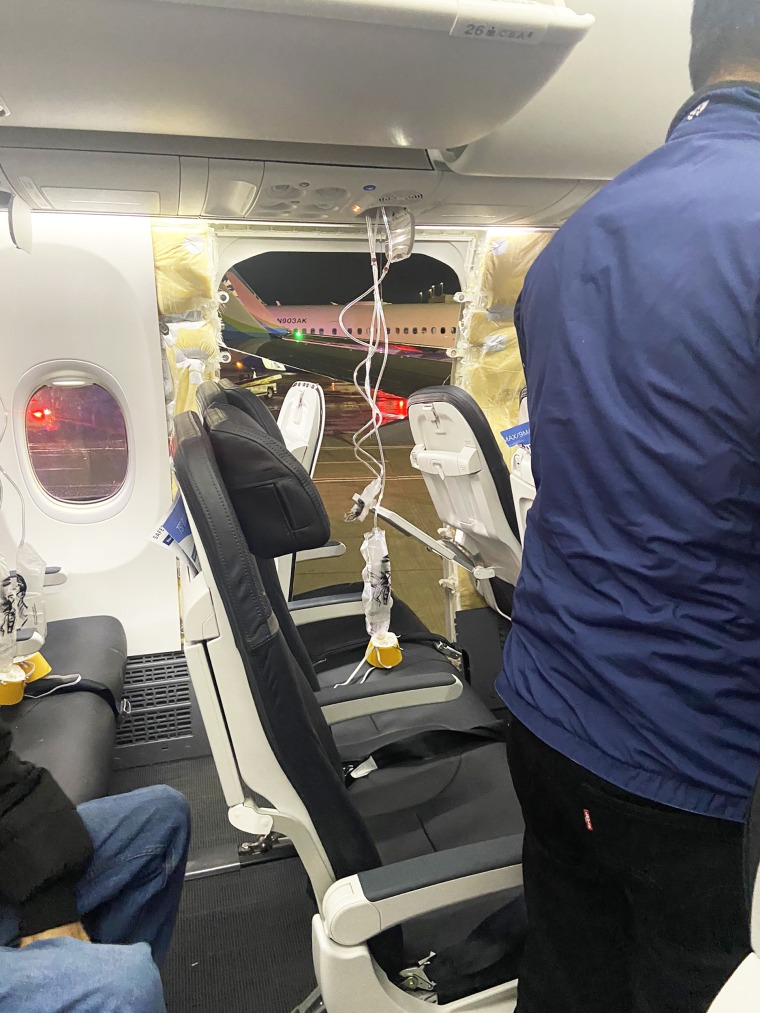
No one was seated near the “plug door” panel that became detached during a flight from Oregon to Southern California on Friday, the NTSB chair said.
Get more news Live Jan. 7, 2024, 6:05 AM UTC By Dennis Romero and Jay BlackmanTragedy may have been averted Friday night when a panel of a Boeing plane blew out as an Alaska Airlines flight traveled at 16,000 feet, an NTSB official said Saturday night.
Seats adjacent to the blowout, which occurred when a panel called a door plug detached from the plane, were not occupied, and the aircraft’s altitude meant passengers were likely seated with seatbelts in use, National Transportation Safety Board Chair Jennifer Homendy said during a news conference Saturday night.
Headrests became detached from two nearby passenger seats, the back of one seat was gone, and there was clothing left in the area following the accident, which depressurized the cabin and resulted in chaos, Homendy said.

“We are very, very fortunate here that this didn’t end up in something more tragic,” the NTSB chair said. “No one was seated in 26A and 26B, where that door plug is.”
The flight was about 10 minutes from its departure airport, Portland International, when the panel detached at 6:38 p.m. Friday with 171 passengers and six crew members on board.
The passenger cabin was subject to rapid decompression after the panel detached and left a large hole in the port side of the aircraft, Homendy said.
For people on board, the accident must have been “truly terrifying,” she said.
The 737 Max 9 was en route to Ontario International Airport in San Bernardino County, California, but it returned to Portland and made an emergency landing, authorities said.
The flight was “only 10 minutes out from the airport when the door blew,” Homendy said.
Authorities were still searching for the door plug, which they believe fell to the ground in the community of Cedar Hills, about 7 miles west of central Portland.
Though no passengers sustained serious injuries, the chair said some on board were treated for minor injuries.
She imagined the accident would could have been much worse if the flight had been at its cruising altitude of 35,000 feet, with people standing, walking or using the restroom.
“We could have ended up with something so much more tragic,” Homendy said.
The blowout resulted in “rapid decompression” of the cabin, the chair said. This can result in hypoxia — oxygen starvation — which can cause dizziness, loss of consciousness, and even permanent brain damage, the FAA says.
Video from on board the flight showed oxygen masks had dropped from the ceiling.
The aircraft was at 16,000 feet, Homendy said, and it soon returned safely to ground level on Friday. Roughly 12,000 feet is the level at which passengers would be safe without supplemental oxygen, an FAA official told NBC affiliate WFLA of Tampa, Florida, last year.
The NTSB is in charge of the investigation and will start its first full day of inquiry Sunday, Homendy said. The chair said she’d avoid speculating on the cause until more was known.
Alaska Airlines said it operates 65 of the Boeing aircraft and that it initially grounded all of them. On Saturday, it said it inspected and cleared 18 of its Boeing 737 Max 9 aircraft.
But those planes will remain on the ground after the FAA issued an emergency airworthiness directive, ordering an estimated 171 of the planes grounded pending inspections with specific parameters, Alaska said on Saturday evening.
Alaska said in a statement the 18, which underwent “in-depth inspections as part of heavy maintenance checks,” were to remain out of service until the airline’s inspections pass muster under the FAA directive.
The groundings prompted the airline to cancel 160 flights, affecting an estimated 23,000 passengers, Alaska said.
The temporary grounding is being felt across the industry.
United Airlines has 79 of the 737 Max 9 aircraft and temporarily suspended service on all of them, it said Saturday. The airline was working to put affected customers onto other planes.
“We are working with the FAA to clarify the inspection process and the requirements for returning all MAX 9 aircraft to service,” the airline said in a statement.
A plug door is a panel sealed in place, in part, with air pressure.
It is used in place of an emergency exit and might be required depending on how an airline configures a plane — namely based on its passenger capacity, Homendy said.
The plane used Friday was configured to carry 178 people, and thus extra emergency exits were not required, she said. For a capacity of 215 passengers, those plug doors would have to be converted to emergency exits, the board chair said.
Passengers on a plane with a plug door would normally see a window at the location, though from the outside it would look like a door.
The NTSB will examine the door plug on the opposite side of the plane, essentially a mirror image of the one that blew out, she said.
Investigators will look at how it was fastened, its structure, as well as the plane’s air pressurization system, among other factors, Homendy said.
The 737 Max 9 involved in Friday’s accident was essentially brand-new, with Homendy saying it was delivered to Alaska Airlines on Nov. 11, and Alaska saying in its statement that it took delivery Oct. 31.
It was prudent for the FAA to ground the model for now, the chair said. “I’m very encouraged that the FAA took action,” she said.
Investigators hope to see more passenger photos and video from the time of the accident, the board chair said, and they are hoping someone will find the door plug and report it to authorities.
Dennis Romero is a breaking news reporter for NBC News Digital.
Jay BlackmanJay Blackman is an NBC News producer covering such areas as transportation, space, medical and consumer issues.